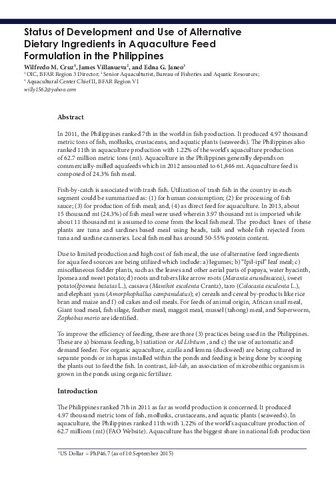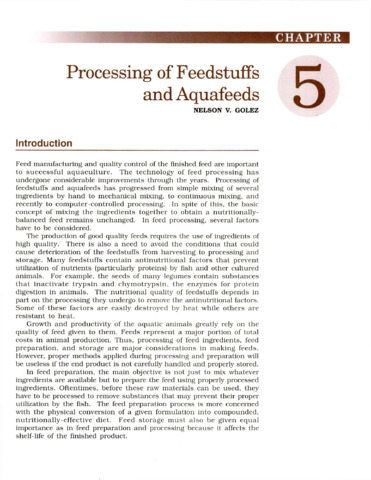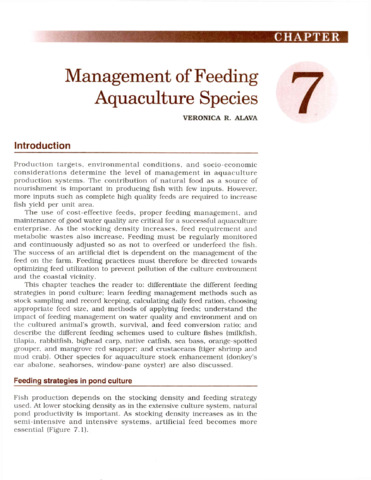Status development and use of alternative dietary ingredients in aquaculture feed formulation in the Philippines
- Global styles
- MLA
- Vancouver
- Elsevier - Harvard
- APA
- Help
Share
Abstract
In 2011, the Philippines ranked 7th in the world in fish production. It produced 4.97 thousand metric tons of fish, mollusks, crustaceans, and aquatic plants (seaweeds). The Philippines also ranked 11th in aquaculture production with 1.22% of the world s aquaculture production of 62.7 million metric tons (mt). Aquaculture in the Philippines generally depends on commercially-milled aquafeeds which in 2012 amounted to 61,846 mt. Aquaculture feed is composed of 24.3% fish meal.
Fish-by-catch is associated with trash fish. Utilization of trash fish in the country in each segment could be summarized as: (1) for human consumption; (2) for processing of fish sauce; (3) for production of fish meal; and, (4) as direct feed for aquaculture. In 2013, about 15 thousand mt (24.3%) of fish meal were used wherein 3.97 thousand mt is imported while about 11 thousand mt is assumed to come from the local fish meal. The product lines of these plants are tuna and sardines based meal using heads, tails and whole fish rejected from tuna and sardine canneries. Local fish meal has around 50-55% protein content.
Due to limited production and high cost of fish meal, the use of alternative feed ingredients for aqua feed sources are being utilized which include: a) legumes; b) Ipil-ipil leaf meal; c) miscellaneous fodder plants, such as the leaves and other aerial parts of papaya, water hyacinth, Ipomea and sweet potato; d) roots and tubers like arrow roots (Maranta arundinacea), sweet potato(Ipomea batatas L.), cassava (Manihot escolenta Crantz), taro (Colocasia esculenta L.), and elephant yam (Amorphophallus campanulatus); e) cereals and cereal by-products like rice bran and maize and f) oil cakes and oil meals. For feeds of animal origin, African snail meal, Giant toad meal, fish silage, feather meal, maggot meal, mussel (tahong) meal, and Superworm, Zophobas morio are identified.
To improve the efficiency of feeding, there are three (3) practices being used in the Philippines. These are a) biomass feeding, b) satiation or Ad Libitum , and c) the use of automatic and demand feeder. For organic aquaculture, azolla and lemna (duckweed) are being cultured in separate ponds or in hapas installed within the ponds and feeding is being done by scooping the plants out to feed the fish. In contrast, lab-lab, an association of microbenthic organism is grown in the ponds using organic fertilizer.
Suggested Citation
Cruz, W. M., Villanueva, J., & Janeo, E. G. (2015). Status development and use of alternative dietary ingredients in aquaculture feed formulation in the Philippines. In M. R. Catacutan, R. M. Coloso, & B. O. Acosta (Eds.), Development and Use of Alternative Dietary Ingredients or Fish Meal Substitutes in Aquaculture Feed Formulation : Proceedings of the ASEAN Regional Technical Consultation on Development and Use of Alternative Dietary Ingredients or Fish Meal Substitutes in Aquaculture Feed Formulation, 9-11 December 2014, Nay Pyi Taw, Myanmar (pp. 23-29). Tigbauan, Iloilo, Philippines: Aquaculture Department, Southeast Asian Fisheries Development Center.
Type
Conference paperISBN
9789719931058
Related items
Showing items related by title, author, creator and subject.
-
Processing of feedstuffs and aquafeeds
Golez, Nelson V. (Aquaculture Department, Southeast Asian Fisheries Development Center, 2002)This chapter will help the reader understand and appreciate the basic principles of processing, preparation, storage, and quality control in the preparation of aquafeeds. The material in this section is presented in sequence ... -
Management of feeding aquaculture species
Alava, Veronica R. (Aquaculture Department, Southeast Asian Fisheries Development Center, 2002)This chapter teaches the reader to: differentiate the different feeding strategies in pond culture; learn feeding management methods such as stock sampling and record keeping, calculating daily feed ration, choosing ... -
Evaluation of feedstuffs and aquafeeds
Teruel, Myrna B. (Aquaculture Department, Southeast Asian Fisheries Development Center, 2002)This chapter discusses how to evaluate feedstuffs and feeds. The results of feed evaluation will be used to ensure the production of high quality feeds for fish, crustaceans, and shellfish.






